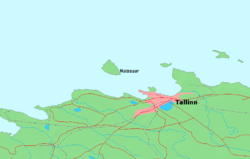Soviet Republic of Soldiers and Fortress-Builders of Nargen
| Soviet Republic of Soldiers and Fortress-Builders of Naissaar | ||||||||||
| Naissaare Nõukogude Vabariik | ||||||||||
| Unrecognized state | ||||||||||
|
||||||||||
|
The island of Naissaar close to the Estonian capital of Tallinn.
|
||||||||||
| Capital | Obernargen (Söderby) | |||||||||
| Languages | Russian, Swedish, Estonian | |||||||||
| Government | Soviet republic | |||||||||
| Chairman¹ | Stepan Petrichenko | |||||||||
| Historical era | World War I | |||||||||
| • | Established | December 1917 | ||||||||
| • | Disestablished | 26 February 1918 | ||||||||
| Area | ||||||||||
| • | 1918 | 18.56 km² (7 sq mi) | ||||||||
| Population | ||||||||||
| • | 1918 est. | 300 | ||||||||
| Density | 16.2 /km² (41.9 /sq mi) | |||||||||
| Currency | "Kerensky ruble" (Keriniki) | |||||||||
|
||||||||||
| ¹ Chairman of the "Council of People's Commissars". | ||||||||||
Naissaar (German: Nargen; Swedish: Nargö) is an island northwest of Tallinn (but belonging to Viimsi Parish) in Estonia. The island covers an area of 18.6 square kilometres (7.2 square miles). It is 8 kilometres (5.0 miles) long and 3.5 kilometres (2.2 miles) wide, and lies about 8.5 kilometres (5.3 miles) from the mainland. The highest point on the island is Kunilamägi, which is 27 metres (89 feet) above sea level. The island consists predominantly of coniferous forest and piles of stones and boulders. As of 2005[update], the island had a population of ten. Now the island has three dozen or so permanent residents and some summer residents. Administratively the island is divided into three villages: Lõunaküla (Storbyn), Tagaküla (Bakbyn) and Väikeheinamaa (Lillängin).
Until the Second World War, the island's population numbered about 450 people of Estonian-Swedish origin. However, these people fled during the war. Naissaar under Soviet rule was a military area and off-limits to the public.
Although the fortifications on the island date back to Peter the Great's scheme to fortify Tallinn, the main fortifications are from the period of Russian rule before World War II. Today, the previous small houses of the Swedish villages are being restored bit-by-bit. Also being restored is a narrow gauge railway that runs from the north to the southern tip of the island.
A notable native of the island was Bernhard Schmidt, the German-Estonian optician who invented the Schmidt telescope in 1930.
The island received a lighthouse in 1788, though the present lighthouse dates to 1960. It is 47 meters tall.
...
Wikipedia


